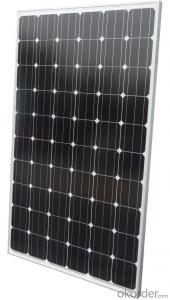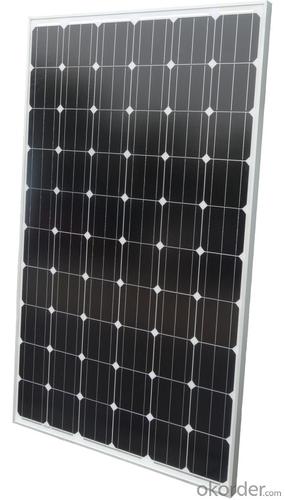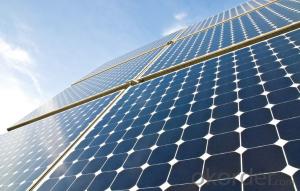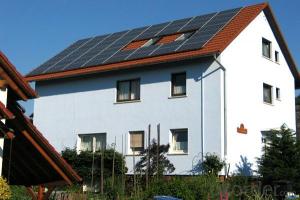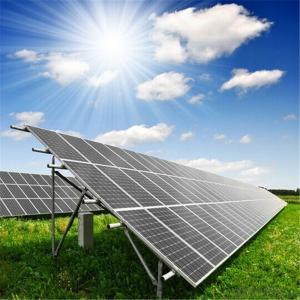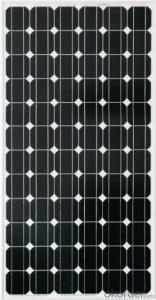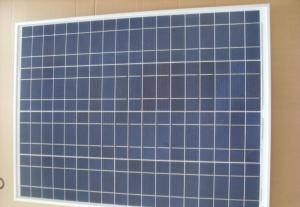Monocrystalline Solar Module 255W for 1500 Sq Ft Home Cost
- Loading Port:
- China Main Port
- Payment Terms:
- TT OR LC
- Min Order Qty:
- -
- Supply Capability:
- -
OKorder Service Pledge
OKorder Financial Service
You Might Also Like
Solar Monocrystalline (210W-225W)
Introduction of Solar Monocrystalline (210W-225W)
Solar modules use light energy (photons) from the sun to generate electricity through the photovoltaic effect. The majority of modules use wafer-based crystalline silicon cells or thin-film cells based on cadmium telluride or silicon. The structural (load carrying) member of a module can either be the top layer or the back layer. Cells must also be protected from mechanical damage and moisture. Most solar modules are rigid, but semi-flexible ones are available, based on thin-film cells. These early solar modules were first used in space in 1958.
CNBM Solar photovoltaic (PV) Panel is designed for large electrical power requirements. It is the optimal choice for both on-grid and off-grid power systems. CNBM Solar panel offers high performance of power per square foot of solar array. Monocrystalline silicon(c-Si): often made using the Czochralski process. Single-crystal wafer cells tend to be expensive, and because they are cut from cylindrical ingots, do not completely cover a square solar cell module without a substantial waste of refined silicon. Hence most c-Si panels have uncovered gaps at the four corners of the cells.
Characteristics of Solar Monocrystalline (210W-225W)
I. Solar Cell : High efficiency crystalline solar cell. Even if under the weak light, the solar module can produce maximum power output.
II. Tempered glass (toughened glass): Anti-reflecting coating and high transmission rate glass increase the power output and mechanical strength of solar module.
III. EVA and TPT: Using high quality EVA and TPT to prevent destroying and water.
IV. AI frame: Without screw, corner connection. 6 holes on the frame can be installed easily.
V. Junction box: Multi function junction box with water proof.
VI. Long lifetime: ≥25 years; Less power decrease.
VII. Good performance of preventing from atrocious weather such as wind and hails.
VIII. Resisting moisture and etching effectively, not effected by geology.
IX. The certificate issued by international authority: UL, TUV, IEC, VDE, CE.
Standard Test Conditions of Solar Monocrystalline (210W-225W)
The opto-electrical specifications shown below are stabilized values being measured at Standard Test Conditions, Irradiance: 1000W/m2, Spectrum: AM1.5 at 25°C, The info below is subject to manufacturing tolerances. Where appropriate minutes of measurement are available and are used for the dimensioning of the installation.
Advantages of Solar Monocrystalline (210W-225W)
• CNBM Solar performance guarantees for 25 years
• 10 years guarantee for workmanship
• Timeliness of delivery
• Quality Products certified (TÜV, UL, CE, VDE, ISO)
CNBM International Corporation's products including Monocrystalline Solar Panel, Polycrystalline Solar Panel have received and enjoyed famous reputation in many countries and regions in the world .As a solar panel manufacturer in China, we strive to provide our customers with excellent service, superior products and unmatched value.
- Q: Can solar panels be installed on a data center or technology facility?
- Yes, solar panels can be installed on a data center or technology facility. Installing solar panels not only helps reduce the environmental impact of these facilities but also provides a sustainable and renewable source of energy. By harnessing the power of the sun, data centers and technology facilities can offset their electricity consumption and potentially even generate surplus energy. This can contribute to cost savings and a greener, more sustainable operation.
- Q: how much energy or electricity a solar panel produces?
- how many solar panels do I need for my house if in average I consume 880 kwh
- Q: i am trying to figure out how many solar panels can be placed on one acre of land and how much they cost to install
- Prices okorder
- Q: Can solar panels be installed on sports stadiums or arenas?
- Yes, solar panels can be installed on sports stadiums or arenas. Many stadiums and arenas around the world have already installed solar panels to generate clean energy and reduce their carbon footprint. These panels are typically placed on the rooftops or parking lots surrounding the facility, taking advantage of the ample space available. Additionally, some stadiums have even incorporated solar panels into their architectural design, creating visually appealing and functional structures.
- Q: Can cold light make solar panels power
- permanent, clean and flexible three major advantages of solar cells long life, as long as the sun exists, solar cells can be an investment and long-term use; compared with thermal power, Solar cells do not cause environmental pollution
- Q: Can solar panels be used in countries with limited sunlight?
- Yes, solar panels can still be used in countries with limited sunlight. While solar panels are most effective in areas with abundant sunlight, they can still generate electricity even in regions with less sunlight. Advances in solar technology and the ability to capture diffuse sunlight have made it possible for solar panels to be used in countries with limited sunlight. Additionally, the efficiency of solar panels has improved over time, allowing them to generate electricity even in low-light conditions.
- Q: How much energy can solar panels generate?
- The amount of energy that solar panels can generate depends on various factors such as the size and efficiency of the panels, the amount of sunlight received, and the geographical location. On average, a residential solar panel system can generate between 10 to 20 kilowatt-hours (kWh) of electricity per day. However, larger commercial or utility-scale solar installations can generate significantly more energy, sometimes even in the megawatt range.
- Q: How do solar panels affect the property's energy efficiency rating?
- Solar panels can significantly improve a property's energy efficiency rating. By harnessing the sun's energy, solar panels generate electricity that can power the property, reducing reliance on traditional energy sources. This results in lower energy consumption and decreased carbon emissions, both of which positively impact the property's energy efficiency rating.
- Q: Can solar panels be installed on beach resorts?
- Yes, solar panels can be installed on beach resorts. In fact, beach resorts provide an excellent opportunity for solar panel installation due to their abundant sunlight exposure. Solar panels can help beach resorts reduce their reliance on traditional energy sources, lower operating costs, and promote sustainable practices. Additionally, solar panels can be integrated into the resort's infrastructure, such as rooftops or shading structures, without significantly impacting the aesthetic appeal of the beach resort.
- Q: i took some solar yard lights apart and put them together in a series. i was told if you take AMPS times VOLTS = WATTS. do you test it with ac volt or dc volts? I tested mine with dc volts and got 4 volts in good sun and had my meter set on Ma or milliamps and got .83 which i am asuming that is .83 of one amp now i took those and multiplied .83 times 4 volts to = 34.03 watts. Is this large enough to charge a car battery in a day? And doese it make a difference for amps on how fast it charges or watts. i also was looking around and found 30 watt panels but had higher amps. I am very interested in building solar panels but i realize i dont know what i need to do to make shur they are big enough. my panel is only 9inch by 0 inch. It seems weird that i am putting out 4 volts
- If a car battery contains 50 amp hours of charge at 2 volts, that's 600 watt hours of energy. divided by 34.03 watts, 7.63 hours to charge completely in direct sunlight. You don't want to connect them all in series. You want about 4 or 5 volts to charge a 2 v battery, so you should connect groups in parallel, and connect those groups in series to make your voltage. You'll end up with the same amount of power, lower volts and higher amps. It will work for trickle charging your battery if it's not too far run down.
Send your message to us
Monocrystalline Solar Module 255W for 1500 Sq Ft Home Cost
- Loading Port:
- China Main Port
- Payment Terms:
- TT OR LC
- Min Order Qty:
- -
- Supply Capability:
- -
OKorder Service Pledge
OKorder Financial Service
Similar products
Hot products
Hot Searches
Related keywords
